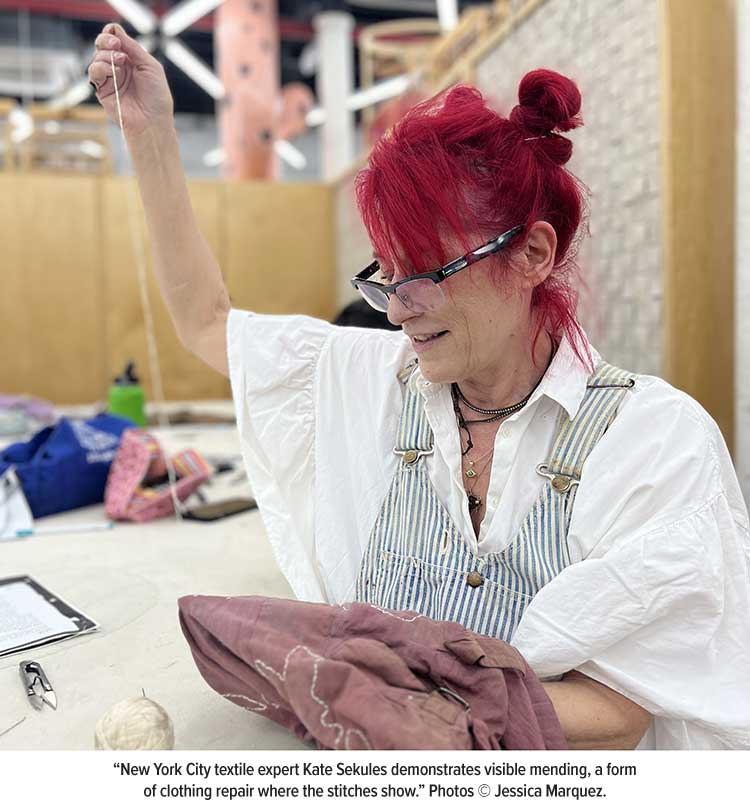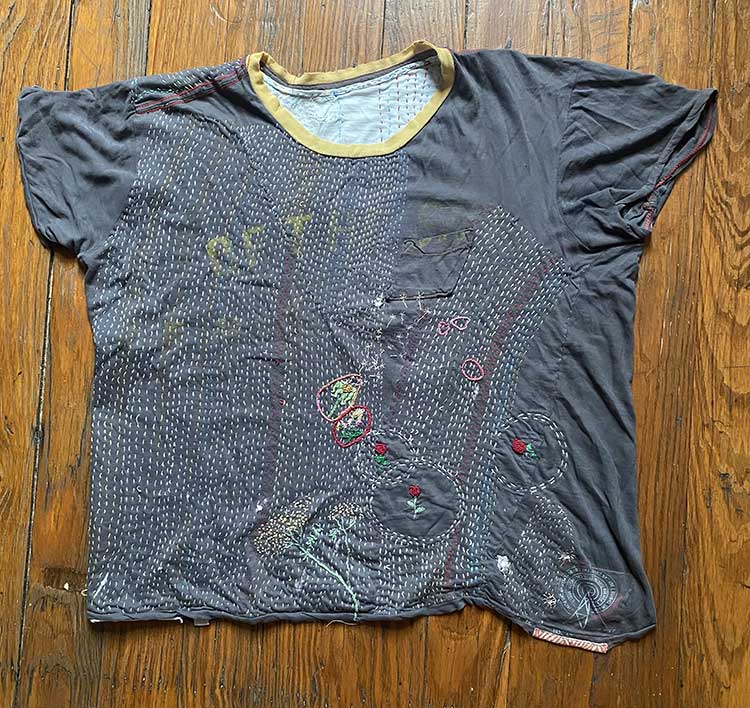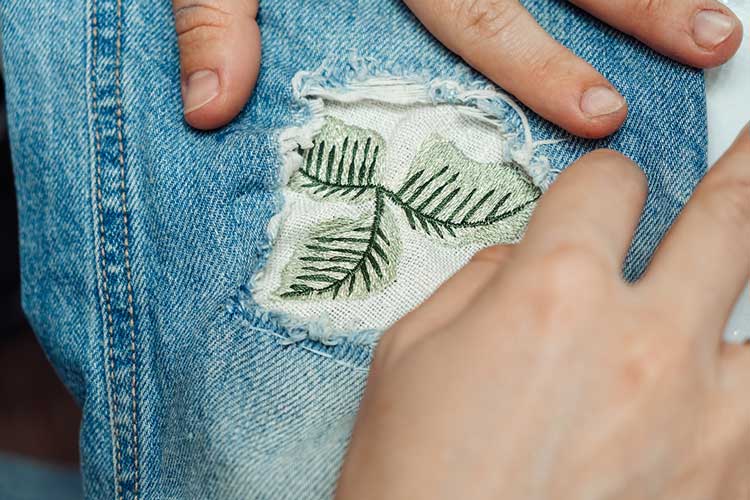Last updated July 2025

One dusty family photo album in my attic holds black-and-white snapshots of my mother and grandmother darning their socks in the early 1950s. “We used burnt-out light bulbs to hold them while we stitched,” my mother remembered.
I was a 1980s kid when I first saw the photos, and the concept of fixing and saving your worn-out clothes felt retrograde even then. Sewing up holes in socks smacked of the long-ago Great Depression; ironing a patch onto the ripped knee of your jeans suggested the street urchins in Les Miserables. My grandmother and mother sewed their own clothes; I don’t even know how to replace a button.
“I think Americans moved away from mending because clothes cost less and it’s easier to replace things,” said Lani Inlander, a personal stylist in Washington, D.C. “Our consumer culture values the new more than preserving the old.”
But growing concerns about over-wasteful shopping and fast fashion—and their effects on the environment—are causing some U.S. consumers to reconsider redoing and repairing their clothes.
“There’s been so much discourse in the fashion industry about overconsumption, and how the production of clothing is a big producer of greenhouse gasses,” said Rebecca Harrison, a Pittsburgh textile expert who ran a clothing mending shop for many years. “Now mending something has become a values thing. If you have a patch on your shirt or pants, it says ‘sustainability is important to me.’”
Here’s what’s happening, and how you can figure out where and how to have your wardrobe repaired, too.
A Brief History of Mending
As long as humans have been wearing clothes, they’ve been fixing up and altering them, using embroidery, patchwork, and other techniques to extend a garment’s life. A stitched-up linen kerchief was found in King Tut’s tomb; colonial American women would wear the same dress for years, updating its silhouette (or taking its seams in or out) as fashions and their bodies changed.
Medieval women who repaired church vestments and poor people’s clothes were considered virtuous. But by Victorian times, patched trousers and weathered shoes branded their wearers as lower class.
Shortages during World Wars I and II forced frugality on masses of Americans, and darning socks or patching up a coat were seen as patriotic acts—and even chic. “England during World War II has to be the best-known era in mending history, thanks to the Board of Trade’s ‘Make Do and Mend’ slogan, which launched with clothes rationing in 1941,” wrote Brooklyn clothing historian Kate Sekules in her book, Mend! A Refashioning Manual and Manifesto. Darning salons opened in major U.S. cities, and repairing garments became vogue again.
Still, by the late 1970s, as hippie “glad rags” were replaced by 1980s shoulder pads and power suits, mending—and shabby clothes in general—were no longer popular. By the turn of the 21st century, fast fashion sashayed in, bringing lower-quality, lower-priced garments to the masses.
“Now you have whole generations of people who have grown up paying $5, $10, or $15 for a pair of jeans,” said Kaitlyn Allen, founder and CEO of MendIt, a marketplace and app for clothing repair services. “It’s hard for them to justify paying $40 to have someone patch up a hole in some pants.”
Mending can also seem unfamiliar if your parents or grandparents didn’t sew, or if the word “tailor” brings to mind a blonde pop star, not needles and pant hems. In fact, a 2020 study MendIt conducted found that 37 percent of Millennials and 44 percent of Gen Z respondents reported being unaware that clothing repair businesses even existed.

The Return of Clothing Repair?
Now, in a world increasingly rocked by climate change and inflation, there’s been a small renaissance in mending. Many younger consumers know that manufacturing has a debilitating impact on the environment, producing an estimated 12 percent of all greenhouse gas emissions, according to the Congressional Budget Office. Plus, discarded garments usually end up in landfills.
“With the COVID-19 pandemic and climate change in 2020, I started to see people upcycling garments and getting into vintage or thrifted clothing,” Harrison said. “Vintage and thrifting go hand in hand with mending. It’s all been inspiring a sea change from fashion uniforms to more personal style and self-expression.”
This is all helping to drive at least a small movement toward purchasing fewer, better items that last longer and are worth repairing—lined pants in natural fibers, silk dresses with more generous seam allowances to leave space to take the piece in or out.
Invisible Mending
The clothing mending most people are familiar with is an invisible mend. The idea? Your moth-eaten wool cardigan will look new again thanks to some subtle darning work, or your favorite shirt can live to see another board meeting if you replace its broken buttons. Such mends can be done by a tailor or drycleaner, though, said Allen, “Many tailors won’t do tiny fixes, since they’d prefer to make a whole garment and make more money.”
Consumers’ Checkbook has ratings of tailors and drycleaners to help you find a pro willing and able to make subtle fixes. Know that, while some drycleaners do mending and small tailoring jobs, ask what a shop can and cannot do before entrusting it to repair multiple moth holes in your prized cashmere pullover. It may usually tackle only smaller tasks, such as redoing a fallen skirt hem. A tailoring shop, on the other hand, should be equipped to handle all types of repairs.
Are your trusty Levi’s or prized wool sport coat worth the cost of mending? “It depends on where the damage is, how visible it is, and what kind of fabric the piece is,” Inlander said. “It can be easier to fix darker-colored or patterned clothing, since you are less likely to see the mending than on something light.”

Visible Mending
Some of the current repair resurgence comes in the form of visible mending, or “VM,” in which you can see the stitches, patches, or darning work. VM riffs on everything from 19th-century crazy quilts to Japanese sashiko, where stitch work on the outside of the fabric shores up and decorates older textiles. “It almost becomes a status symbol if you sew on an unusually shaped patch or embroider a flower over a hole in a sweater,” Harrison said.
“Now, if you’re lower income and suffering from clothes insecurity, you might only be able to buy seemingly perfect clothing,” Sekules said. “But many people who have money crave things that look handmade, unique, and gorgeous. It’s almost been reversed.”
Mending businesses such as Harrison’s have popped up in cities around the U.S., allowing customers to drop off (or mail in) jeans or moth-chewed wool blazers to be sewn back to life. Often, the mend is a creative collaboration between sewers and clients. You can find a list of menders, many of whom offer mail-in services, via the MendIt app.
Or research some of Consumers’ Checkbook’s recommended tailors; some businesses, particularly ones run by younger sewers, can do artful, visible fixes as well as traditional tasks.

Want to Try to DIY?
You can also mend clothes yourself. “These sewing concepts are pretty easy to learn, even if you’ve never picked up a needle,” Sekules said. “It’s a bit of trial and error, but there are loads of books and videos online. People have been doing it for millennia.” You can also take basic sewing classes via community centers, mending shops, or fabric stores.
I even watched a few YouTube videos about sewing on buttons. I bought a needle and thread, and I tried it myself. Success! Maybe next, I’ll darn some socks, just like Mom.


